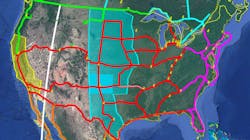And I thought 2020 was a weird year! So far 2021 is shaping up with its own brand of strangeness. I know it’s early in the year, but so far ERCOT’s rolling disaster gets my vote for bizarreness. I mean snow on Galveston Island, 5º in Houston, not to mention ERCOT’s power grid within minutes of collapsing. A collapsing grid really got everyone’s attention and started some discussing a national electric grid or rather the lack of one. A national grid has been discussed for many years, but only discussed.
There are three major power interconnections in the lower 48, but all of the focus lately has been on the ERCOT interconnection and its ability or lack of ability to transfer power in and out of ERCOT. Personally, I find it more surprising that there hasn’t been much discussion about the Eastern and Western Interconnections’ lack of power transfer between each other. Think about it, they’re also isolated, and much like ERCOT, that’s impacting their resilience, reliability, and performance. At least that’s what a growing number of experts are saying.
These two NERC Interconnections represent roughly 950 gigawatts (GWs) of generation, but there is only about 1.3 GWs of transfer capacity between them. The transfer is provided by seven HVDC (high voltage direct current) back-to-back converter stations along an imaginary line that runs north to south from eastern Montana to west Texas. This imaginary line is called the “seam.” What got me thinking about this was an email I received from my old friend, Dale Osborn.
A Seamless Grid
Dale’s email brought me up to date on the National Renewable Energy Laboratory’s (NREL) Interconnections Seams study. Dale has been an advisor to NREL’s Seams project. The Seams study has been a massive effort involving regional grid operators, utilities, universities, and several national labs. Since I had built one of those converter stations along the seam, I have been interested in the project since its start.
NREL finally published their Seams study in late October of 2020 after a lot of effort by the previous administration to bury it. Basically, the Seams project modeled 32 different grid scenarios for improving the transfer of power between the Western, the Eastern, and ERCOT Interconnections. The most ambitious of these was to turn the three interconnections into a single national macrogrid.
Let’s focus our discussion on the continental wide grid that would take advantage of its size to smooth out the intermittent nature renewables across regions. Think about the sun setting on the east coast, the solar power from the west coast providing the east coast with electricity. When the sun set in the west, wind power from the east would replace it. Interestingly, all 32 of the scenarios Seams ran showed a positive benefit to cost ratio.
What’s a Macrogrid
The term macrogrid may be more recognizable as the mega grid, or perhaps the hybrid grid: the configuration goes by many names. It has been compared to the interstate highway system, but it’s more than that. I like to think of it as our traditional HVAC (high voltage alternating current) grid beefed up with ultra-HVAC (i.e., lines operating at voltages greater than 800 kV). The HVAC is overlayed with an HVDC transmission backbone. The HVDC would also include ultra-HVDC (i.e., lines operating at voltages ±800 kV and higher).
This sounds a little like wishful thinking or maybe science fiction except for the fact that off-the-shelf technology exists for all the components needed to build a macrogrid, and it is being done in several countries right now. India, Brazil, and China have been building ultra-high voltage (UHV) transmission for many years.
China, however, leads the world in UHV transmission with 25 operating UHV transmission lines. In 2020 China announced they are planning to expand their UHV system by spend about $26.8 billion on 14 UHV projects. These projects include 6 ultra-HVDC transmission line projects, a back-to-back converter station, and 7 ultra-HVAC transmission projects.
All of this begs the question, would a macrogrid have made the ERCOT extreme weather event a non-event? One scenario of the Seams study had four transmission lines with an import capability of 62,000 MWs. All other things being equal, I think the answer would be yes. An UHV transmission system that combines HVAC and HVDC networks would be more flexible than today’s interconnections. Interestingly, the world is doing this, and the US is thinking about it. Hmm, what’s wrong with that picture!
About the Author
Gene Wolf
Technical Editor
Gene Wolf has been designing and building substations and other high technology facilities for over 32 years. He received his BSEE from Wichita State University. He received his MSEE from New Mexico State University. He is a registered professional engineer in the states of California and New Mexico. He started his career as a substation engineer for Kansas Gas and Electric, retired as the Principal Engineer of Stations for Public Service Company of New Mexico recently, and founded Lone Wolf Engineering, LLC an engineering consulting company.
Gene is widely recognized as a technical leader in the electric power industry. Gene is a fellow of the IEEE. He is the former Chairman of the IEEE PES T&D Committee. He has held the position of the Chairman of the HVDC & FACTS Subcommittee and membership in many T&D working groups. Gene is also active in renewable energy. He sponsored the formation of the “Integration of Renewable Energy into the Transmission & Distribution Grids” subcommittee and the “Intelligent Grid Transmission and Distribution” subcommittee within the Transmission and Distribution committee.
